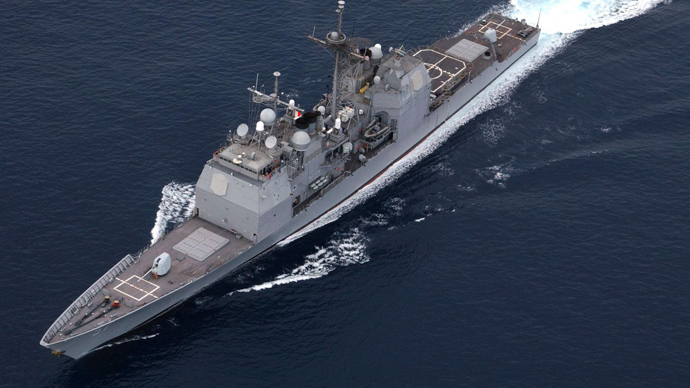NATO missile shield in Europe stays, despite understanding over ‘nuclear Iran fairytale’

Despite a negotiated understanding with Tehran on the nuclear issue, the US is still going ahead with its missile defense installations in Europe, being deployed over a perceived threat from “nuclear Iran” – a pretext which Moscow called a “fairytale.”
“The threat to NATO countries posed by the proliferation of ballistic missiles continues to increase… the framework [of the Iran nuclear program] agreement does not change that fact,” NATO’s spokeswoman Oana Lungescu told Sputnik.
Russia’s deputy Prime Minister and a former representative of Moscow to NATO, Dmitry Rogozin, was quick to react saying that despite the understanding reached in Switzerland, the controversial missile shield in Europe stays because “the Missile Defense System was never about Iran.”
НАТО не откажется от создания системы ПРО в Европе, несмотря на договорённость с Ираном http://t.co/u2CDD1pa7Y Потому что ПРО не из-за Ирана
— Dmitry Rogozin (@Rogozin) April 3, 2015
On Thursday, after 8 days of marathon negotiations, Tehran agreed with world powers to severely limit its uranium enrichment capabilities, practically freezing its atomic research and development for at least a decade, and therefore giving up any potential means to create an alleged atomic weapon.
Washington for years insisted that the missile defense system was intended to protect against potential missile threats from rogue elements such as Iran and North Korea. Russia strongly objected to new unilateral military installations by NATO and proposed the creation of a joint security system, but Washington rejected the idea.
Meanwhile the head of the Russian State Duma Foreign Relations Committee Aleksey Pushkov has called the official American explanation for placing the missile defense system in Europe a “fairytale.”
Strait of Gibraltar- Guided-missile cruiser USS Vicksburg transits as part of Theodore Roosevelt Carrier Strike Group pic.twitter.com/u44LNqPgzF
— US Mission to NATO (@USNATO) April 2, 2015
“NATO won’t give up on the missile shield in Europe? Who would have thought it! These fairytales about a ‘treat’ from Iran and North Korea were for idiots. Now NATO doesn’t even have these fairytales,” Pushkov said on Twitter.
Some political analysts agree with the Russian officials’ assessments.
“I think many would like to hear from [Barack Obama] that Washington and Tehran are now friends, but friends do not threaten each other, and the US missile defense installations in Eastern Europe are still targeting Iran and Russia. All this meaning that America’s geopolitical adversaries remain the same,” Reza Hojjat Shamami, a prominent Iranian political analyst and expert on Eurasian affairs, told Sputnik.
Orhan Gafarli, an expert on Eurasian security with Turkey’s Center for Strategic Analysis, meanwhile told the agency that if deployment of the system continues, it will become “perfectly clear” that the initial US plan was to encircle Russia.
“In this case Washington would find it real hard to keep misleading the world about its real intentions,” he told Sputnik.
READ MORE: ‘Unprecedented & dangerous step’: Russia slams NATO troop build-up
Russia’s permanent representative to NATO Alexander Grushko said earlier that NATO’s decision to strengthen its eastern borders are changing the military and political situation in Europe. Such a buildup poses a great risk for Russia, unbalancing a strategic parity, and will be taken into account in military planning.
The alliance recent moves violate the Russia-NATO Founding Act, under which NATO agreed not permanently station “substantial combat forces” near the Russian border in Estonia, Latvia and Lithuania, Foreign Ministry spokesman Aleksandr Lukashevich said this week.
But despite a plan to more than double NATO’s Rapid Response Force stationed close to Russia to include 30,000 military personnel, the alliance still insists that “this presence is rotational and well below any reasonable definition of substantial combat forces.”
. @USArmyEurope air defense unit begins combined #missiledefense exercise in Poland: http://t.co/WdpZ6z3GWopic.twitter.com/FYOSAUCQYi
— Soldiers Magazine (@SoldiersMag) March 24, 2015
Russia sees the recent actions as additional proof that NATO is still an anti-Russian military bloc that has taken advantage of the Ukrainian conflict, using it as a pretext for a military build-up in Eastern Europe.
“NATO is developing its rapid response forces and is boosting its infrastructure near our borders, we are registering attempts to violate nuclear parity and the creation of the European and Asia-Pacific segments of the missile defense systems is being sped up,” Russian President Vladimir Putin said last week.












